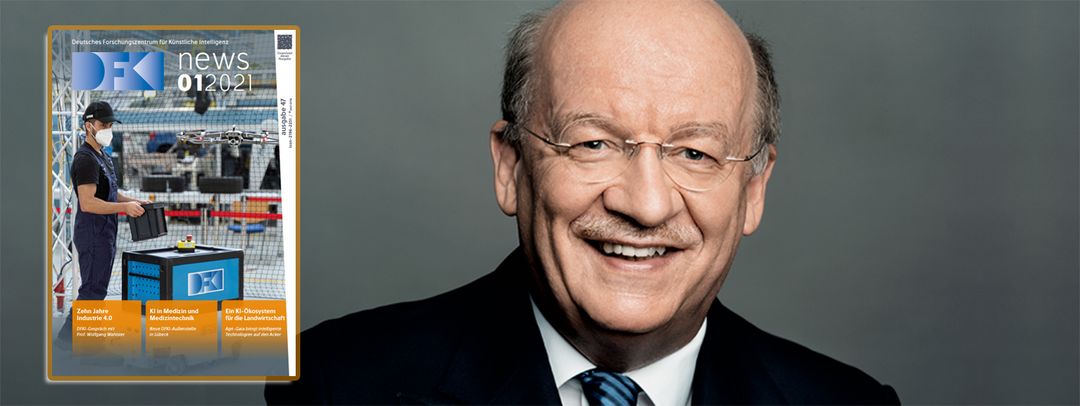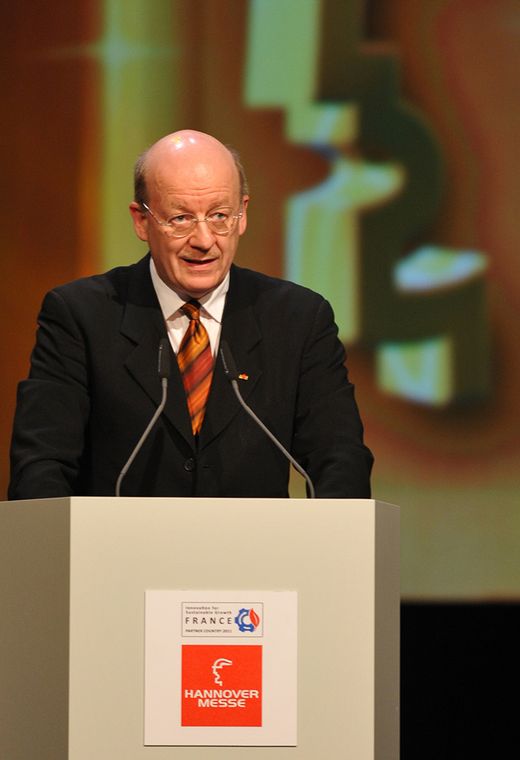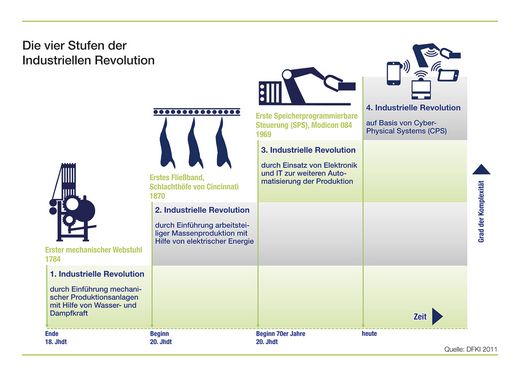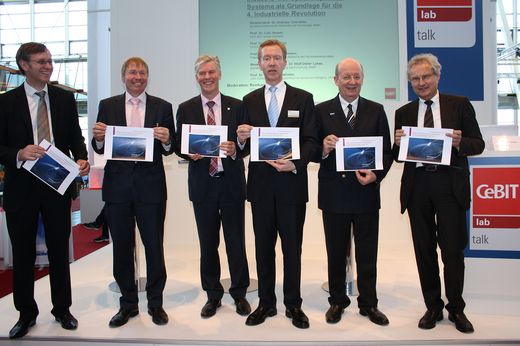Almost ten years ago to the day, the article that initially introduced the engaging concept of INDUSTRIE 4.0 appeared. “INDUSTRIE 4.0: The 4th Industrial Revolution and the Internet of Things” was published by VDI (Association of German Engineers) on April 1, 2011, just in advance of the Hannover Fair (Messe) 2011. The article was co-authored by Prof. Wolfgang Wahlster, DFKI, Prof. Henning Kagermann, acatech, and Prof. Wolf-Dieter Lukas, Federal Ministry of Education and Research (BMBF).
DFKI corporate spokesman Reinhard Karger caught up to Prof. Wolfgang Wahlster, founding director of DFKI and former CEO, who still accompanies the work of DFKI as Chief Executive Advisor (CEA), for this interview.
Prof. Wahlster, please review for us the evolution of the concept and designation of the word mark “INDUSTRIE 4.0.”
As a member of the German government‘s Industry-Science Research Alliance from 2006-2013, my job was to support Germany‘s High-Tech Strategy and develop specific future projects. Together with my colleagues Henning Kagermann and Johannes Helbig in the Communication Promoters Group, we were responsible for innovation in the Information and Communication Technologies (ICT). Under the motto “Ignite Ideas,” Annette Schavan, Germany‘s former Minister for Education and Research, asked us to define ambitious, forward-looking projects with high economic and social potential that would bring German research strengths to bear for the practical benefit of major industries. In September 2010, the Promoters Group decided to define a future project based on scientific trends like the Internet of Things, Internet of Services, and Cyber-Physical Systems (CPS). We positioned the project in the area of cyber-physical production systems, since at that time every second job in Germany depended directly or indirectly on the manufacturing of physical products. By December 2010, at a meeting at the German Academy of Science and Engineering (acatech) in Berlin with my colleagues Kagermann and Lukas, we were of the opinion that the term “cyber-physical production systems” was too unwieldy a name for the future project, so I suggested the intuitively understood “Industrie 4.0.” The designator “4.0” represents the 4th Industrial Revolution, while simultaneously indicating the essential role software plays (in the manner of naming versions in the IT branch).
When did the planning for the future project officially begin and when was the first use of the term at a major trade event?
In January 2011, the Research Alliance determined that a future project titled “INDUSTRIE 4.0: Germany as the lead provider of cyber-physical systems by 2020” should be developed. Although the acatech study at the time, directed by our colleague Manfred Broy, identified many important application areas, Mr. Kagermann, Mr. Lukas, and I chose to focus on applications in the manufacturing industry – a good decision, as evidenced by the success of INDUSTRIE 4.0.The opening event of the Hannover Messe on April 3, 2011 was attended by the Chancellor Angela Merkel, numerous politicians, and approximately 3,000 industry leaders, and I was able to introduce the term “Industrie 4.0” for the first time to important decision-makers in my speech regarding the work of the Hermes Award jury.
At the opening event of the Hannover Messe on April 3, 2011, in the presence of the Chancellor Angela Merkel, numerous politicians and around 3,000 executives, I was then able to present the term „INDUSTRIE 4.0" for the first time to important decision-makers in my speech on the jury work for the Hermes Award: “To remain a center of manufacturing today implies becoming fit for the 4th Industrial Revolution which is powered by the Internet. The Internet of Things establishes a bridge be-tween the virtual and tangible worlds. For industrial manufacturing, this approach represents a paradigm shift. An unfinished product controls its own production processes, monitors the relevant environmental parameters using embedded sensors, and initiates the appropriate corrective actions in the event of a malfunction – all simultaneously as an observer and an actor...”
The Chancellor spontaneously picked up on the term in her subsequent opening remarks. This opened the flood gates and the future project was the topic of discussion at the evening dinner, with intense interest and some initial skepticism by traditional equipment manufacturers. For a strategy meeting at acatech in June 2011, I asked DFKI graphic specialist Renato Orsini to prepare a graphic according to my conception of the four stages of the Industrial Revolution. Today, it is used in thousands of variations, even in textbooks and, unfortunately, more often than not, plagiarized. Together with this catchy graphic, the word mark “INDUSTRIE 4.0” became the catalyst for the exponential spread of the concept.
How did the term continue to spread even further?
The concept rapidly spread virally around the world and is in use today, like the words “kindergarten” and “autobahn” with their association to Germany. INDUS-TRIE 4.0 is accepted as a German export hit that has received worldwide attention and recognition in busi-ness, science, and politics. This is the first time we have been able to establish an innovative concept from Germany in the international world of high tech, where for so many years the terms have originated in America or Asia. In the last ten years, more than 100,000 publications, 10,000 conferences, and 1,000 project consortia have addressed the technical implementation of INDUSTRIE 4.0; resulting in more than 25 million Internet references to the term.
Did any preliminary work exist on which to base INDUSTRIE 4.0?
Yes, for the specification of INDUSTRIE 4.0 objectives, we built on the research results of our world’s first “Smart Factory” at DFKI-Kaiserslautern, which has been under development since 2005. Also, I had been leading the BMBF SemProm project on semantic product memories since 2008, and, based on the demonstrator operated by colleague Detlef Zühlke, we assigned a so-called digital twin to each factory module and each unfinished product. A digital twin stores the function and the entire life his-tory of a physical object in a machine-understandable representation and actively controls the production process itself, making it economically feasible to produce even in very small lots. We knew what we were doing when we introduced the term “Industrie 4.0” to the world.
How many of the “INDUSTRIE 4.0” concepts that you and your colleagues Kagermann and Lukas published on April 1, 2011 have since become today’s reality?
The Internet of Things and the cyber-physical systems that use it already exist in modern factories today. The digital connectivity between all machines, tools, workpieces, and factory workers has also made tremendous progress in existing factories. Steady advances in new low-cost sensors and wireless links enable the upgrade of the sensor systems so more and more production steps can be monitored by multi-sensor fusion in real-time, for example, for quality control and other purposes. More and more digital twins are also being realized on the basis of our earlier work on active digital object memories. We are nearing the goal of having a digital image that can be automatically updated in real-time for each physical object and used for control impulses.
New factories today are always designed as flexible factories. The days of having a factory designed for only one specific product line are truly over. For example, with the volatility of the mobility revolution, every factory for vehicle engines must be convertible to alternative power trains at minimum time and financial expense. The traditional automation pyramid has been eliminated in favor of heterarchical service-oriented architectures that support distributed production. Today, quite a few recently built “smart factories” are already implementing many of the basic principles of INDUSTRIE 4.0: Plug & Produce, cycle independent matrix-production architectures with configurable production units and fast changeover times even for the smallest lot sizes with a high degree of product individualization, variable intra-logistics in combination with real-time production planning as well as location-based services for all workers, production equipment, and products in production. Factory floor positioning systems have been vastly improved using AI-based visual SL AM (Simultaneous Localization and Mapping) methods for mobile systems like autonomous forklifts. The highly parallel execution of neural processes on very powerful graphics cards (GPU computing) has significantly improved landmarks recognition, necessary to give mobile robots the freedom to navigate.
You often speak of “industrial AI” as a primary research focus in Germany. What are the areas of application and how does Germany compare internationally on the topic of industrial AI?
AI is spearheading a second wave of digital manufacturing because the mass data generated in manufacturing can only be exploited and monetized with AI in new value creation processes. The American and Chinese Internet companies are leading the way in the application of AI as hyperscalers in the area of B2C. Germany also has outstanding R&D capabilities in industrial AI, as well as in actual practice. Industrial AI is not about ad placement or product recommendations, but rather about innovative production, processes, and business models. Consider the systems from global suppliers like Bosch, ZF, Continental, or the SMEs like Harting, Claas, and Sartorius as well as SAP and Software AG, primarily built to provide the neural pathways of a company, but are actually making corporate knowledge digitally available and accessible for business development. Let's not forget that German OEMs like VW, BMW, and Daimler, are also driving industrial AI as they make greater use of AI systems and convert their factories worldwide to INDUSTRIE 4.0 step by step.
Was it possible for Germany to achieve the goal of becoming the leading supplier of components for the implementation of cyber-physical production systems by the year 2020 as announced in 2011?
Yes, our traditional factory suppliers like Siemens, Bosch-Rexroth, and ABB, but even more so, our many hidden champions among the SMEs have contributed the first solutions and still maintain a lead of one or two years. You will not find a smart factory anywhere in the world not equipped with German companies’ software and hardware components. The challenge by American companies with the “Indus-trial Internet” was too short-sighted. Although upgrading the networking and communication infrastructure is a prerequisite, this in itself is by no means the answer for INDUSTRIE 4.0. Also, an IoT platform does not pro-vide a viable solution for disruptive plant models if they lack the semantic coding of domain knowledge by excellent engineers and skilled workers, intelligent controls, and digital twins. Perhaps more important are the solutions for retrofit-ting existing factories with networked IoT boxes, distributed sensor technology, and intelligent control stations based on digital twins. Specializing in the digital enhancement of high precision, robust classic production plants has made German medium-sized companies highly sought-after suppliers, especially in China. Mobile tablets, smartphones, smartwatches, and data glasses have also enabled a new generation of worker-specific cognitive assistants, resulting in significant increases in productivity, product quality, job satisfaction, safety, and transparency. People remain at the center, continue to learn throughout their lives, feel no loss of control, and gain more enjoyment from their work.
What does international cooperation on INDUSTRIE 4.0 look like from a DFKI perspective?
The state visit by Chancellor Angela Merkel to the Czech Republic in August 2016 provided the framework for the launch of a bi-national initiative with former Czech Prime Minister Bohuslav Sobotka, which resulted in the establishment of the German-Czech Innovation Lab for Human-Robot-Collaboration in INDUSTRIE 4.0 located in Prague. The cooperation with colleagues at the Czech Technical University in Prague is excellent. This Research and Innovation Center for Advanced Industrial Production (RICAIP) will present its findings at the digital Hannover Fair 2021. The research focus is on Human-Robot-Collaboration in industrial manufacturing. The goal is to develop hybrid teams of humans and robots working together, preferably side by side. For this to work, machines need to know the context of an action and the goal, so they can interpret the status and evaluate their contribution to a solution. We also have Smart Factory cooperation agreements with France and the Netherlands. China is currently making very targeted investments in order to use INDUSTRIE 4.0 to transform its manufacturing sector, which just a few years ago was still at an Industry 2.0 level, to be the best in the world. Japan is already further along because they understood the new paradigm faster and more deeply, and Korea is also catching up. The USA was late to recognize the full scope and depth of the paradigm shift and got off to a false start with the initial one-sided focus on the “Industrial Internet.” Fundamental work on INDUSTRIE 4.0 was not started there until much later.
What new technology trends will impact the 4th Industrial Revolution in the next ten years?
Six new megatrends will be crucial. These are: industrial AI, edge-computing (to include the edge cloud), 5G in the factory, team robotics, autonomous intra-logistics systems, and reliable data infrastructures like the one provided by GAIA-X. Industrial AI will power the second wave in digital manufacturing. The first wave, the digitalization of all production and supply chain data and its availability via cloud systems, is now largely complete. Today, this digital data can be analyzed by AI systems and interpreted in context, enabling its active use in the future in new value chains and innovative business models.
The use of digital training data for machine learning systems means that AI systems will be used not only for predictive maintenance, which is already widespread, but increasingly for incremental quality control, mostly in combination with optical sensors. The goal of the next phase of INDUSTRIE 4.0 is AI-based, zero-defect production. The new generation of smart factories will have a self-learning capability and modular long-term autonomy, in addition to extreme flexibility. These characteristics will guarantee highly robust production, occupational safety, and a high level of resource efficiency. Capability-based production architecture will ensure expandability and flexibility in the next stage of INDUSTRIE 4.0. Edge devices with high bandwidth and the guaranteed low latency of 5G will be interconnected with private 5G-cam-pus networks to a local edge cloud, which then meets re-al-time factory requirements. Hybrid teams of workers and collaborative robots with various capabilities will create a new type of team robotics, with human-machine interaction guided by human specialists at the center working with robots in tandem, hand-in-hand to solve complex manufacturing tasks. Data infrastructures will take into account industry requirements and data sovereignty, distributed /multi-cloud and edge support, as well as the provision of services. For example, for the medium-sized agricultural and food industry, the Agri-Gaia consortium managed by DFKI is developing an AI ecosystem for food production within the concept of INDUSTRIE 4.0 based on the reference architecture of GAIA-X. The automotive industry, in contrast, has completely different requirements for a data infrastructure based on GAIA-X to implement INDUSTRIE 4.0 in a manufacturing plant.
What are the most important success factors for INDUSTRIE 4.0 in the second half or, the next ten years?
Research and innovation must not let up in the next phase of this 4th industrial revolution. Investments must continue, particularly in industrial AI as the second wave of the digital transformation. The enormous potential of INDUSTRIE 4.0 is far from exhausted. Interoperability in terms of software and hardware components will play a decisive role, especially to ensure international market access for German SMEs and start-ups. Standards, norms, and certifications are essential drivers for interoperable solutions. Germany must take on a pioneering role in this, while also focusing on the resilience and security of the solutions offered. Ultimately, we must strive for the right balance between greater digital sovereignty and providing reliable and resilient solutions as a leading industrial supplier for global markets.
The pandemic experience has taught us that we must develop solutions to avoid breaks in supply chains or production stoppages due to short-term staff shortages. The latest “home office” technologies are little help here; rather, “home workbenches” are required: software solutions with remote access to cyber-physical systems, including teleoperation with physical avatars to allow the mobile control, maintenance, and repair of factories. In addition to these technological innovations, the next decade still requires the support of governments and trade unions. Successful value creation still requires cooperation at the platform level in the next legislative period if we are to reap the lasting economic and social benefits of the 4th industrial revolution started in Germany.




